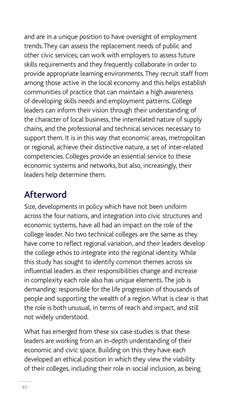
40
and are in a unique position to have oversight of employment
trends. They can assess the replacement needs of public and
other civic services; can work with employers to assess future
skills requirements and they frequently collaborate in order to
provide appropriate learning environments. They recruit staff from
among those active in the local economy and this helps establish
communities of practice that can maintain a high awareness
of developing skills needs and employment patterns. College
leaders can inform their vision through their understanding of
the character of local business, the interrelated nature of supply
chains, and the professional and technical services necessary to
support them. It is in this way that economic areas, metropolitan
or regional, achieve their distinctive nature, a set of inter-related
competencies. Colleges provide an essential service to these
economic systems and networks, but also, increasingly, their
leaders help determine them.
Afterword
Size, developments in policy which have not been uniform
across the four nations, and integration into civic structures and
economic systems, have all had an impact on the role of the
college leader. No two technical colleges are the same as they
have come to reflect regional variation, and their leaders develop
the college ethos to integrate into the regional identity. While
this study has sought to identify common themes across six
influential leaders as their responsibilities change and increase
in complexity each role also has unique elements. The job is
demanding: responsible for the life progression of thousands of
people and supporting the wealth of a region. What is clear is that
the role is both unusual, in terms of reach and impact, and still
not widely understood.
What has emerged from these six case studies is that these
leaders are working from an in-depth understanding of their
economic and civic space. Building on this they have each
developed an ethical position in which they view the viability
of their colleges, including their role in social inclusion, as being